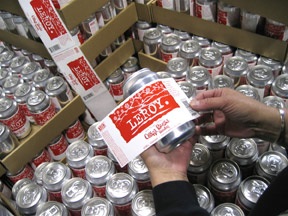No, no drinking was conducted before posting of this dispatch.
Yes, Dog Star Brewing Co. – in Napa Valley, it figures – makes beer for dogs.
Yes, all Rogue Nation Embassies – also known as pubs – offer gourmet treats for dogs.
First, the doggie beer. The Napa Valley Register has all the details about Dog Star’s Happy Tail Ale – which might have started as a lark, but turned into a serious venture.
The basics:
Dog Star’s first Happy Tail Ale recipe consisted of soda water, yellow food coloring and beef bouillon. Right away the Millers learned one quick lesson about combining bouillon cubes in soda water, “It explodes like a volcano,” said Jamie with a rueful laugh. Additionally, they discovered dogs really don’t like carbonation. “It upsets their stomachs,” she said.
With that, they began more research. Through visits to microbreweries and brewing suppliers Jamie learned more about beermaking. “I had only been a beer drinker, now I was turning into a beer brewer,” she said.
Jamie eventually came up with a formula very similar to beer but without alcohol, carbonation or hops, which can cause dog seizures. The final recipe consists of water, malted barley, glucosamine, vitamin E and lactic acid. Natural beef drippings provide additional flavor and sodium benzoate prevents bottle fermenting.
There’s plenty more to the story – local bars are even stocking the beer.
Rogue now offers Gulley’s Dog Menu at all six of its brewery/restaurants. A burger and fires combination runs $9.95 but most items are around a dollar. These include a carob cupcake, a peanut butter bone and a croissant with beef.
Rogue has long been dog friendly. Brewmaster John Maier’s best friend, Brewer, is pictured on the front of the website (click on his photo), as well as some Rogue beer bottles, condom package, T-shirts and posters.
He is also Master of Ceremonies at Doggie Days fundraisers held periodically at Rogue pubs.
 On Thursday, Oskar Blues Brewery will release two hand-canned seasonal beers in Colorado.
On Thursday, Oskar Blues Brewery will release two hand-canned seasonal beers in Colorado.
 Rodenbach and Rodenbach Grand Cru – which returned to the U.S. market earlier this year – are now available in New York and North Carolina and are on the way to Ohio.
Rodenbach and Rodenbach Grand Cru – which returned to the U.S. market earlier this year – are now available in New York and North Carolina and are on the way to Ohio.